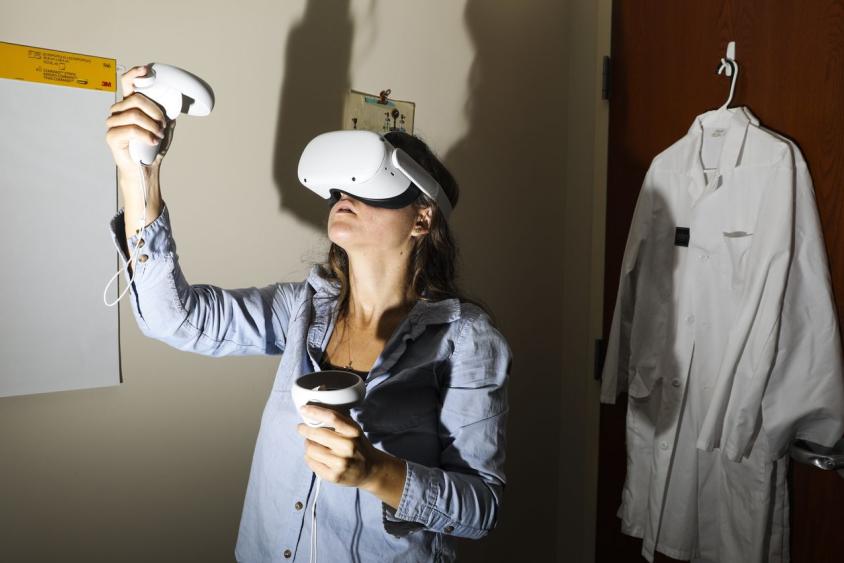Virtual Reality Puts Drug Researchers Inside the Molecules They Study

Dr. Jackie von Salm, the co-founder and chief scientific officer of Psilera Inc., uses Nanome’s software to research drug compounds. Photo by Eve Edelheit
The immersive technology reveals clues about how compounds might work, with the aim of speeding up the drug-discovery process
The Future of Everything covers the innovation and technology transforming the way we live, work and play, with monthly issues on education, money, cities and more. This month is Health, online starting Sept. 3 and in the paper on Sept. 10.
Chemist and entrepreneur Jackie von Salm recently walked inside a receptor in the brain to inspect a new drug compound. As she looked at the brightly colored, cascading ribbons around her, she noted something: Part of the atomic structure, a series of thick, orange rods and hexagons, jutted toward her in an odd way, suggesting that the compound, a derivative of the psychedelic DMT, might be effective at treating addiction without having hallucinogenic effects.
“This is weird,” says Dr. von Salm, the co-founder and chief scientific officer of Psilera Inc., a Tampa, Fla.-based company working to turn psychedelics into treatments for addiction, neurodegenerative diseases and mood disorders. “But it might be really unique and special.”
The odd positioning of the compound might be the right shape to latch onto serotonin receptors in the brain that are involved with hallucination and addiction. That insight was possible thanks to a technology more closely associated with gamers than scientists: Virtual reality.
Dr. von Salm is one of a growing number of drug-discovery researchers who are using VR to see, in new ways, the molecules they have long studied on computer screens. Their goal is to investigate subtle changes in the distance, shape and chemical properties of atomic structures that could give them clues about how well a drug might work and speed up the drug-discovery process.
Dr. von Salm was wearing a VR headset that uses 3-D molecular modeling software made by Nanome, a San Diego-based startup. The software incorporates experimental and theoretical data about molecular structures based on methods including computational chemistry and crystallography, a technique used to identify the arrangement of atoms.
Dr. von Salm’s ponytailed avatar was able to walk into and around the compound’s molecular structure, exploring 360-degree views that can be difficult and time-consuming to see with traditional software.
In VR, drug molecules and proteins, color-coded by the scientists, loom large. Using hand controllers, scientists can grab the structures to rotate them, make them bigger or smaller and get a closer look at their positioning. This can make it easier for them to identify promising molecules faster than with existing methods.
Adding sound and artificial intelligence to VR could expand the technology’s value.
Markus Buehler, a materials scientist and engineering professor at the Massachusetts Institute of Technology, is combining VR with sound waves to detect subtle changes in molecular motions that would otherwise be difficult to observe on computers.
Dr. Buehler’s team is developing a system that could allow a user wearing a VR headset to walk through 3-D models of coronaviruses, while hearing various sounds to represent the vibrational frequencies of different parts of the viruses. “You begin to hear specific regions of resonances that are really interesting,” he says.
Read the full article on the Wall Street Journal.


